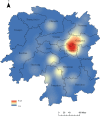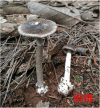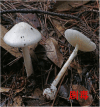Mushroom poisoning deaths and prevention practices in Hunan, 2014-2023
- PMID: 40522929
- PMCID: PMC12169554
- DOI: 10.1371/journal.pone.0326107
Mushroom poisoning deaths and prevention practices in Hunan, 2014-2023
Abstract
Background: Wild mushroom poisoning is a major cause of foodborne illness-related deaths in Hunan Province. By analyzing the epidemiological characteristics of fatal incidents due to wild mushroom poisoning in Hunan Province over the past decade and preventive measures implemented in recent years, in this study, we aimed to provide insights for nationwide prevention and control of wild mushroom poisoning, focusing on reducing mortality.
Methods: Data from the "Foodborne Disease Outbreak Surveillance System" in Hunan Province were used to describe the characteristics of wild mushroom poisoning. Kernel density analysis was performed using ArcMap 10.8.1 to identify spatial clustering.
Results: It showed that from 2014 to 2023, 80 fatal wild mushroom poisoning incidents and 111 deaths, with a case fatality rate of 1.5%, were reported in Hunan Province. June (40 events, 50.0%) and August (17 events, 21.3%) are the peak periods for wild mushroom poisoning. The species most frequently associated with fatal poisoning were Russula subnigricans (20 events, 25.0%), Amanita fuliginea (18 events, 22.5%), and Amanita rimosa (11 events, 13.5%). Kernel density analysis indicated that the fatalities were primarily concentrated in the central and eastern regions of Hunan Province. All (100%) fatal incidence collected from households with poisoning caused by accidental harvesting and consumption. Rural areas accounted for 93.8% of the fatal incidents. The highest proportion of deaths (48.7%) occurred in the age group of 60 years and above.
Conclusion: Fatalities due to wild mushroom poisoning incidents exhibit seasonal and regional variations. We call for multi-sectoral collaboration in prevention and control efforts, focusing on key populations, regions, and time to conduct public education and promotion and ensure smooth access to medical care, which are crucial strategies for preventing wild mushroom poisoning incidents and reducing mortality.
Copyright: © 2025 Wu et al. This is an open access article distributed under the terms of the Creative Commons Attribution License, which permits unrestricted use, distribution, and reproduction in any medium, provided the original author and source are credited.
Conflict of interest statement
The authors have declared that no competing interests exist.
Figures




References
-
- Tuliguer LH, Bao H, Li Y. The newly revised list of poisonous mushrooms in China. Mycology Research. 2024;1–27. doi: 10.13341/j.jfr.2024.0010 - DOI
MeSH terms
LinkOut - more resources
Full Text Sources
Miscellaneous

